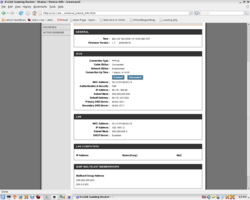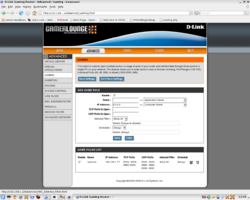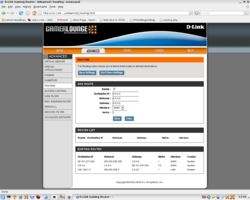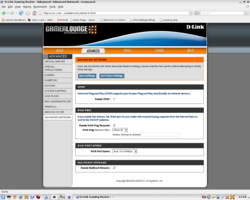Network Settings
From OpenSimulator
| Languages: |
|
Contents |
OpenSim Grid - Ports for Grid Services - from version 0.7.0
Ports used for Grid services (such as login, user control, grid management, asset services and inventory services, etc) are run within a Robust shell started by Robust.exe. They can be configured to state which port they run on, and the services can be run across multiple machines as desired to balance load.
But in a simple grid with all the Robust services running in a single Robust.exe shell it is normal to just use two ports for all services:
TCP/8002 - All externally and user accessible OpenSim services TCP/8003 - All internal OpenSim servics
Hence, 8002 should be accessible through your firewall, but in this simple setup 8003 can be behind a firewall.
OpenSim Grid - Ports for Region Simulators
One port must be open on any computer running an OpenSim.exe simulator that attaches to a grid. OpenSim.exe can be run on same computer (or one of computers) on which the Grid Services run, or on a separate computer. One OpenSim.exe can be used to run a number of regions, but each region must have its own unique port on that computer.
TCP+UDP/9000 - Default Port for First Simulator - grid, regions, and clients talk to these TCP+UDP/9001 - Default Prot for Second Simulator - grid, regions, and clients talk to these TCP+UDP/900x - Default Port for further Simulators...
In fact you can choose which port you prefer to use for each region on grid using the InternalPort parameter in the relevant Region description .ini file
XML-RPC communications, if enabled, are on the port specified in the [XMLRPC] section XmlRpcPort parameter (default port 20800).
TCP+UDP/20800 - Default Port for XML-RPC communications to a specific OpenSim.ini simulator (and all regions on it)
OpenSim StandAlone
- UDP+TCP/9000 - Services and the single region simulator are used via this single port
- Check your /bin/Regions/ directory which contain one or more Region description files. Three of the fields will specify the internal IP address or domain name, the external IP address or domain name, and the port to be used for the region (which must be unique for each region) - something like this:
InternalAddress = "0.0.0.0" InternalPort = 9000 ExternalHostName = 82.73.39.77"
- Retrieve your external_host_name
- Get your internal_ip_address (using ipconfig for windows, or ifconfig for linux)
- Make sure the settings match
If you have a router in front of your internet-modem, check out NAT and Port Forwarding. Else you're good to go.
Optional and Add-on Module Specific Ports
FreeSWITCH Voice
TCP+UDP 5040 - SIP Ports (5040 for default call profile) TCP+UDP 1723 - H.323 ports for call setup
Mumble Voice
SIP Ports ICE Ports
OpenSim Grid - Ports for Grid Services - up to version 0.6.9
Note this is no longer the current version...
- TCP/8000 - Reserved
- TCP/8001 - Grid Server - Regions and other grid services talk to this
- TCP/8002 - User Server and Login Services - Clients, Regions, and other grid services talk to this
- TCP/8003 - Asset Services - Regions and other grid services talk to this
- TCP/8004 - Inventory Services - Regions and other grid services talk to this
- TCP/8005 - Reserved (Dispatch Services)
- TCP/8006 - Messaging Server
- TCP/8895 - Used in early releases for region-to-region communications
NAT and Port Forwarding
Straightforward
If your host does not have a public IP address (eg it is hidden behind a home router) you will have issues hosting grid and region servers if you plan on connecting clients to it on both sides of the router, however this can be worked around through the use of port forwarding and ip-redirecting.This will also correct issues where the client hangs at region handshake.
- Set internal_ip_address to your local LAN-ip(e.g. 192.168.2.1) (region xml-file)
- Set the external_host_name to your external IP-Address (Not a hostname, since DNS-resolving doesn't work properly) (region xml-file)
- Forward the appropriate ports to the OpenSim-server on both UDP and TCP (router-setup)
- Open appropriate ports on the OpenSim-server's firewall on both UDP and TCP
- Reroute traffic for Linux:
- iptables -t nat -A OUTPUT --dst EXTERNAL_IP -p tcp --dport 9000:9010 -j DNAT --to-destination INTERNAL_IP
- iptables -t nat -A OUTPUT --dst EXTERNAL_IP -p udp --dport 9000:9010 -j DNAT --to-destination INTERNAL_IP
- service iptables restart
Those iptables lines will redirect any traffic going to EXTERNAL_IP on ports 9000 to 9010 to INTERNAL_IP. The internal ip is the LAN-IP of your server, and External ip is your internet IP. Use the above iptables command on all internal machines except your gateway/router. This assumes your gateway/router machine does not also host your sim. This also assume you have a default ACCEPT policy on your internal machines. So to connect from within your LAN, use the above iptables commands to reroute the traffic to the server internal ip.
- Reroute traffic for Windows:
- netsh (this method needs experimentation and elaboration. Please see the Discussion page for some guesswork on where to start)
- note from paulieFlomar: I tried using Windows built-in tools like FireWall, netsh, and IP Security Policy. My experience with these tools was unsuccessful. I then tried to create an outgoing rule with some third-party firewall products. I tried ZoneAlarm and Sunbelt Firewall. Neither of these products would allow me to create outgoing rules. Finally, I tried creating an outgoing rule in my Linux IP Tables firewall. This worked. I created 2 rules which I placed in a firewall script, before my NAT rule. The rules were:
- netsh (this method needs experimentation and elaboration. Please see the Discussion page for some guesswork on where to start)
iptables -t nat -A PREROUTING --dst EXTERNAL_IP -p tcp --dport 9000:9010 -j DNAT --to-destination INTERNAL_IP
iptables -t nat -A PREROUTING --dst EXTERNAL_IP -p udp --dport 9000:9010 -j DNAT --to-destination INTERNAL_IP
These rules worked. I can now access my region from my LAN.
Optional:
- Register an external domain-name (for external connections)
- Use Bind for internal domain-name resolving
DynDNS loopback
This method was used and successfully tested using www.dyndns.com (creates a virtual domain for your pc/ip, like yourcomputer.ath.cx) as loopback for devices on a LAN with three machines (pentium 2.8ghz running windows xp - internet server , amd opteron running ubuntu 7.10 64bit - as opensim server - and MacBook with OSX 10.4.11 - as client), a modem (thomson/alcatel speedtouch 330) and a mini-switch (which brand no one ever heard of). The connection of these machines is made as following: Modem -> Win Pc -> Switch -> Mac and Ubuntu. Dyndns is used to loopback to the Win Pc, and then it forwards the request to the internal LAN opensim server, which grants everything for the client. As for the client, if he is inside the private LAN then he is now actually someone on the internet requesting for access to the opensim server. Thus, if the client is someone on the internet then he will be treated like that. Tricky ? Further details ahead:
Method:
- Set the simulator listening IP address to your dyndns domain - edit opensim/bin/Regions/default.xml; and change the external_host_name to external_host_name="yourcomputer.ath.cx". Leave internal_ip_address "0.0.0.0" and port "9000".
- Set the client (SecondLife Viewer) -loginuri to "yourcomputer.ath.cx:8002" (the port used was 8002, yours can be different if you configured it that way) - i didnt used the -loginserver flag also.
- Port Forward the above ports on the internet server (in this case, win xp). You do so by creating exceptions in Windows Firewall for the above mentioned ports, and for both connections: Internet Connection and LAN - this keeps the ports open for the web requests to travel over the private network.
- Edit "hosts" file (on windows, this is C:\Windows\System32\Drivers\etc\hosts and on Unix-type systems, this is /etc/hosts) entry on your internet server (in this case, win xp box) and add the following line: xxx.xxx.xxx.xxx yourcomputer.ath.cx. Of course, xxx.xxx.xxx.xxx is your opensim server internal LAN IP.
yourcomputer.ath.cx is now available for everyone to connect and you may login with the client!
DynDNS and the free IPCop Linux Firewall
Here an other way with the IPCop Linux Firewall, DynDNS and a OpenSimulator server
- Setup an IPCop firewall with 3 interfaces (red, green, orange) and put the OpenSimulator server on the orange interface (all OpenSimulator server's on one Linux box). Red is the internet, green is your lan.
- Setup the DynDNS service on the IPCop Firewall.
- change the external_host_name in the default.xml to the DynDNS name
- do'nt change the internal_ip_address in the default.XML, it should be 0.0.0.0
- if there, delete all loopbacks in /etc/hosts only 127.0.0.1 should be localhost
- customize the Port Forwarding on the IPCop Firewall (8002 TCP, 9000 UDP/TCP and for every additonal region 900X UDP/TCP). Port forwarding should be set to the (orange) interface adress of the OpenSimulator Box
Then it should be possible to conenct from inside the LAN (green) and it is also possible to conenct from the internet (over the red interface). (well, the inside-lan connections are also made now over the RED interface, but infact, this is in the same ISP network, it should be quit fast ;-)
- Attention : the ports on the IPCop Firewall must also be open if you connect from inside (green) to your OpenSimulator Grid !
If you are using the OS WebGui, do'nt forget to set the "SMTP AUTH" in your email server. Most of the dynamic IPs are blocked at ISP level so the new users do'nt get any confirmation email.
This was tested with the Hippo OpenSim Viewer and with the Login URL : http://DynDNSName:8002
Local connections with ZyXEL DSL modem/router and NAT/Port Forwarding
This solution works with the ZyXEL Prestige 660ME-61 DSL Router. It may work with other models made by ZyXEL.
Method:
- Connect by TELNET to your ZyXEL DSL modem. Use the same IP address that you would if you were using the web interface. For example, the default ip on most Embarq ZyXEL DSL modems is 192.168.2.1.
telnet 192.168.2.1
- Enter your password. If you do not know it, try just pressing <ENTER> or ask your ISP for the password. They may or may not give it to you.
- Select menu option "24. System Maintenance" from the menu.
Copyright (c) 1994 - 2004 ZyXEL Communications Corp.
Prestige 660ME-61 Main Menu
Getting Started Advanced Management
1. General Setup 21. Filter Set Configuration
2. WAN Backup Setup 22. SNMP Configuration
3. LAN Setup 23. System Password
4. Internet Access Setup 24. System Maintenance
25. IP Routing Policy Setup
Advanced Applications 26. Schedule Setup
11. Remote Node Setup
12. Static Routing Setup
15. NAT Setup 99. Exit
Enter Menu Selection Number:
- Select menu option "8. Command Interpreter Mode" from the menu
Menu 24 - System Maintenance
1. System Status
2. System Information and Console Port Speed
3. Log and Trace
4. Diagnostic
5. Backup Configuration
6. Restore Configuration
7. Upload Firmware
8. Command Interpreter Mode
9. Call Control
10. Time and Date Setting
11. Remote Management
Enter Menu Selection Number:
- At the prompt type "ip nat loopback on".
Copyright (c) 1994 - 2004 ZyXEL Communications Corp. Sprint > ip nat loopback on
- At the prompt type "exit".
Sprint> exit
- Select menu option "99. Exit"
- Follow all other steps for configuring and starting your server as outlined in Getting Started.
Local connections with the DLink GamerLounge Extreme N router
Networking and router configurations have been responsible for 98% of all trouble I have had setting up and operating OpenSimulator region server software. Insuring that you have a capable router properly configured should be the first thing on the list of configuration checkpoints for a smooth and trouble-free path to OpenSimulator software operations in GridMode.
Below is a series of screen snapshots with the key pages of my router configuration interface with proper settings displayed.
The settings below assume that you have an otherwise working connection and do not touch on such subjects as port conflicts or logging your network onto your ISP's provider network.
- provided that all information supplied in ~opensim/bin/OpenSim.ini and in your ~opensim/Regions/*.xml are properly configured, this should have you up and running.
===Local and Internet connections with Linux iptables and NAT/Port Forwarding=== Please don't copy this verbatim - much more should go into a firewall setup, but this will at a bare minimum get NAT working with forwarding to your OpenSim server from both inside and outside your LAN.
Example firewall.sh script:echo 1 > /proc/sys/net/ipv4/ip_forward echo 1 > /proc/sys/net/netfilter/nf_conntrack_tcp_be_liberal echo 0 > /proc/sys/net/ipv4/conf/all/accept_redirects echo 0 > /proc/sys/net/ipv4/conf/all/accept_source_route echo 0 > /proc/sys/net/ipv4/conf/all/send_redirects echo 1 > /proc/sys/net/ipv4/conf/all/log_martians echo 1 > /proc/sys/net/ipv4/conf/all/rp_filter modprobe nf_conntrack_ftp modprobe nf_nat_ftp INT = "eth0" # your internal network card on the firewall EXT = "eth1" # Your external network card on the firewall IPTABLES = "/sbin/iptables" # Path to your iptables executable OPENSIMEXT = "66.102.1.103/32" # Example external IP - replace with yours OPENSIMINT = "192.168.1.240/32" # Internal IP of your OpenSim server INTSUBNET = "192.168.1.0/24" # Your internal subnet range # Flush rules when we are restarting the script $IPTABLES -F $IPTABLES -F -t nat $IPTABLES -F -t mangle # Set up sane defaults $IPTABLES -P INPUT DROP $IPTABLES -P OUTPUT ACCEPT $IPTABLES -P FORWARD DROP # Allow all connections from inside the network to the firewall on all ports $IPTABLES -A INPUT -i $INT -j ACCEPT # Allow all outbound connections from the inside. Much better to limit this... $IPTABLES -A FORWARD -o $EXT -j ACCEPT # Configure basic NAT $IPTABLES -A FORWARD -i $EXT -m state --state RELATED,ESTABLISHED -j ACCEPT $IPTABLES -t nat -A POSTROUTING -o $EXT -j SNAT --to-source $OUTNAT # Configure forwarding for OpenSim (you need to add ports if you are not running in standalone # or if you are running more than one region) $IPTABLES -A PREROUTING -p tcp -d $OPENSIMEXT --dport 9000 -j DNAT --to-destination $OPENSIMINT $IPTABLES -A PREROUTING -p udp -d $OPENSIMEXT --dport 9000 -j DNAT --to-destination $OPENSIMINT # Now for the magical juice that lets inside users and outside users both access your server # Configure to allow internal network users to access the OpenSim server using the # external IP address. This fixes failing to connect to regions over UDP due to NAT config # Make sure you configure the proper external IP for each of your regions $IPTABLES -t nat -A PREROUTING -i $INT -s $INTSUBNET -d $OPENSIMEXT -j DNAT --to-destination $OPENSIMINT $IPTABLES -t nat -A POSTROUTING -o $INT -s $INTSUBNET -d $OPENSIMINT -j DNAT --to-source $OPENSIMEXT
NOTE: Contrary to what is displayed above, DHCP services are not required to operate OpenSimulator server software.





